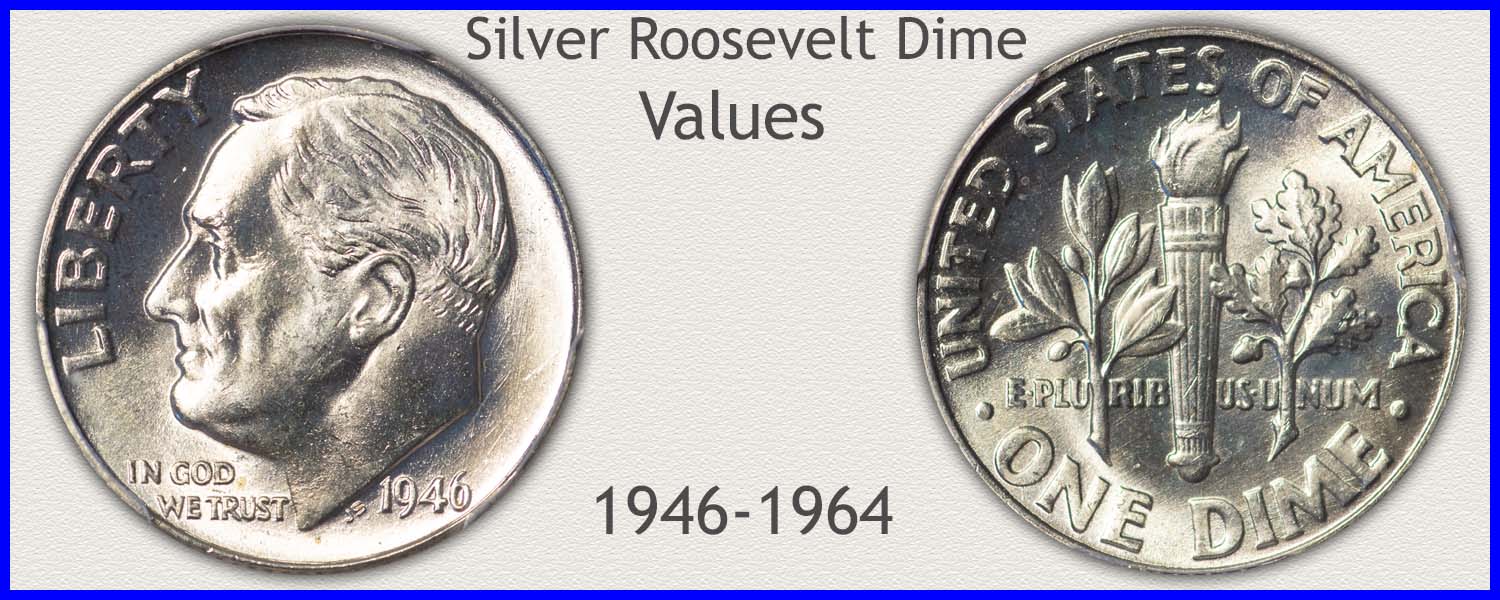Coin Values Moving with Precious Metals: Up-Dated 4/14/2025: Gold $3226 | Silver $31.88
1960 Dime Value
Mint varieties and condition are identified to find 1960 dime value above silver base price. Currently 4/14/2025 each is a strong $2.13 . Silver trading in the $31.88 range is a start.
How much a 1960 dime is worth is found by a step-by-step method to determine any collector premium. A demand is placed on all silver Roosevelt dimes by collectors, both new and advanced. A young collector seeks the affordable lightly circulated examples. Higher quality sets are assembled around mint state pieces with outstanding eye appeal.
Follow the step-by-step approach found below.
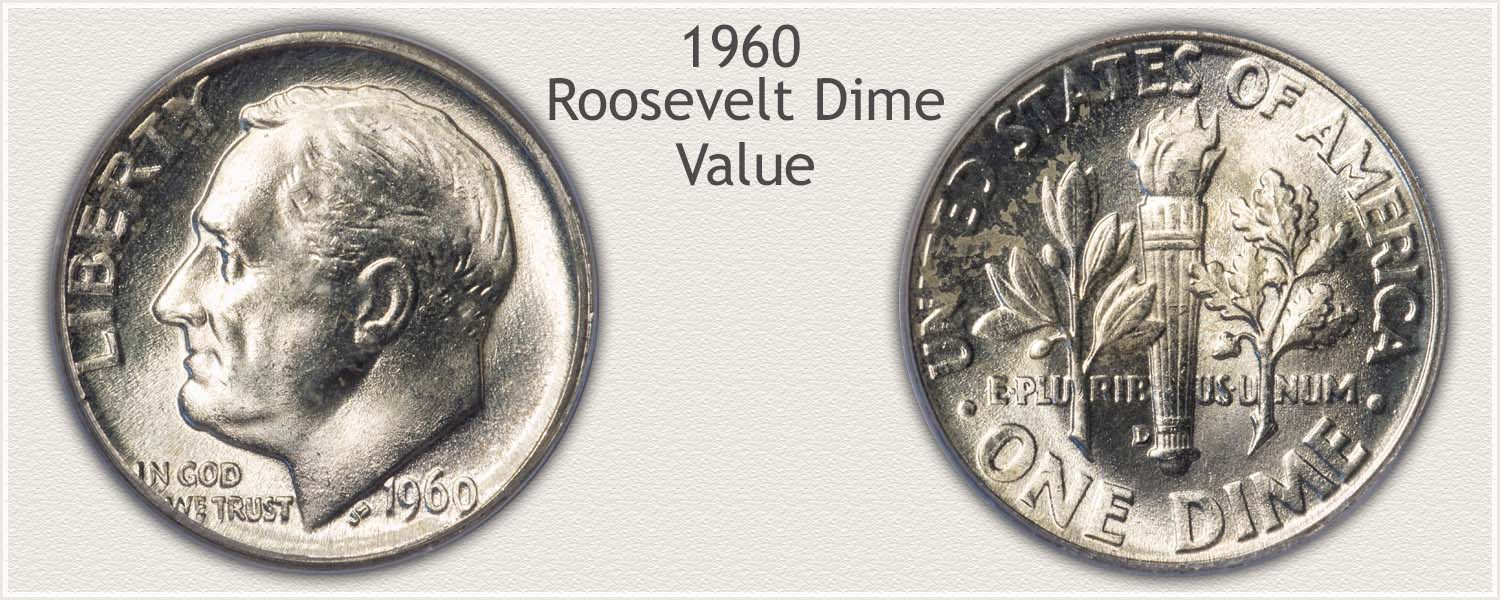
Steps Leading to Value:
- Step 1: Date and Mintmark Variety - As a collectible, old dimes are identified by date and mint variety. Confirm both to accurately find its place on the chart.
- Step 2: Grading Condition - Bullion quality dimes are traded with the price of silver as a base. Grading determines the higher premium collector coins. Using images, a comparison separates the two.
- Step 3: Special Qualities - Collectors are the driving force to higher value. Small points are examined that alert to a collectible quality dime.
| 1960 Dime Value | ||||
|---|---|---|---|---|
| Condition of Coin | ||||
| Date | Good | Fine | Extremely Fine | Mint State |
| Roosevelt Dime Values Updated | 4/14/2025 | |||
| 1960 | $2.13 | $2.13 | $2.13 | $2.63 |
| 1960 D | $2.13 | $2.13 | $2.13 | $2.63 |
To judge both the bullion quality and the collector quality 1960 dime, a few steps are taken to accurately recognize the difference.
Step 1: | Date and Mintmark Combination Confirmed
Two Varieties of 1960 Dimes to Recognize
Entering a new decade, Roosevelt dime production remained on a steady pace. Over 270 million of these silver dimes entered circulation from two mints.
Philadelphia and Denver mints struck dimes in 1960 and each is collected separately as part of collections. Most are valued based on silver content and its premium now over face value. Confirm both date and mint varieties to find its place on the chart.
1960-D Roosevelt Dime
"D" Mintmark on Reverse: Denver Mint Struck the Coin
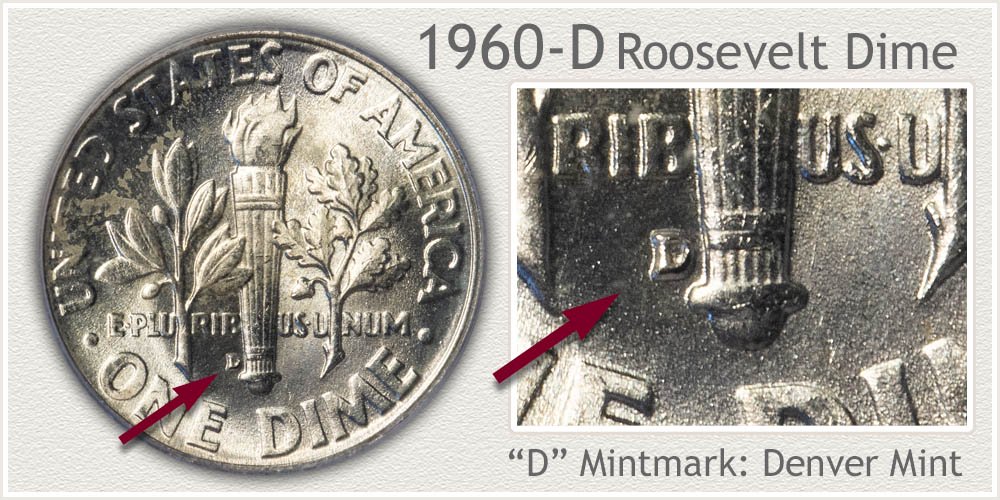
Denver mint continued to increase its production of dimes in 1960, demand required over 200 million from the facility. These are quite abundant today. High grade - condition examples are affordable. Each 1960 Denver dime is a silver alloy with a nice premium because of the precious metal.
Denver coinage has a "D" mintmark to identify its production. Look to the reverse at the base of the torch, on the left the "D" is Denver's mintmark.
1960 Roosevelt Dime
No Mintmark on Reverse: Philadelphia Mint Struck the Coin
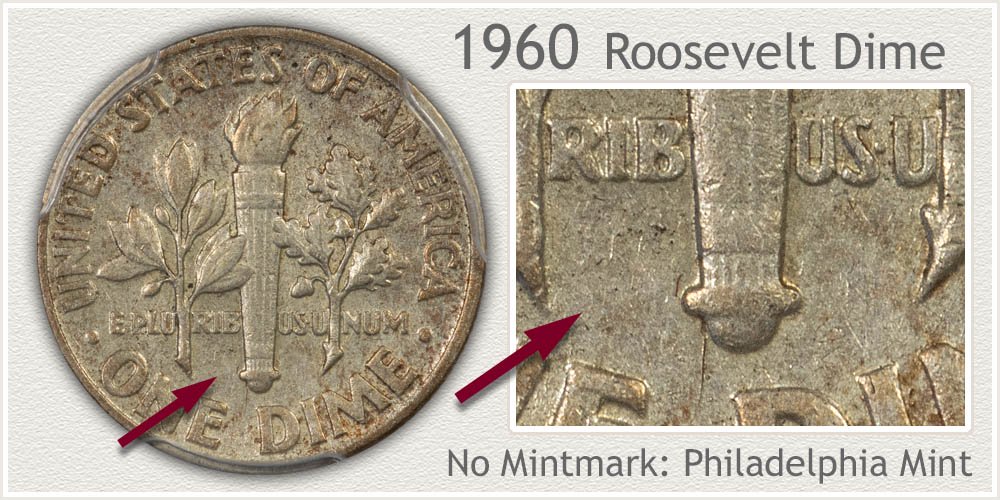
Philadelphia is the second mint to strike dimes in 1960. The Philadelphia variety is available today, over 70 million struck. Popularity of the series creates a steady demand for examples in mint state condition - no wear to the surface. Worn examples are primarily valued close to the silver content. Collectors however note the mint variety as part of complete set of silver era Roosevelt dimes.
To identify the Philadelphia variety, look at the reverse. At the base of the torch, if the left side is without a mintmark, Philadelphia struck the coin. No mintmark was used by Philadelphia in 1960.
Step 2: | Judge Condition to Identify Grade
Grade and 1960 Dime Value
Part of the appeal to collectors is completeness of design on Roosevelt dimes. A pleasing coin with full details is the condition and quality in demand.
Grading is the process to define condition. Grades represent stages of wear to the surface and these grades are used on value charts. Comparing to images of coins in different stages of wear narrows the condition into a grade.
Use the descriptions to focus on specific areas to judge condition. A good start is viewing a mint state coin with no wear to see the design with all original details.
Mint State Grade
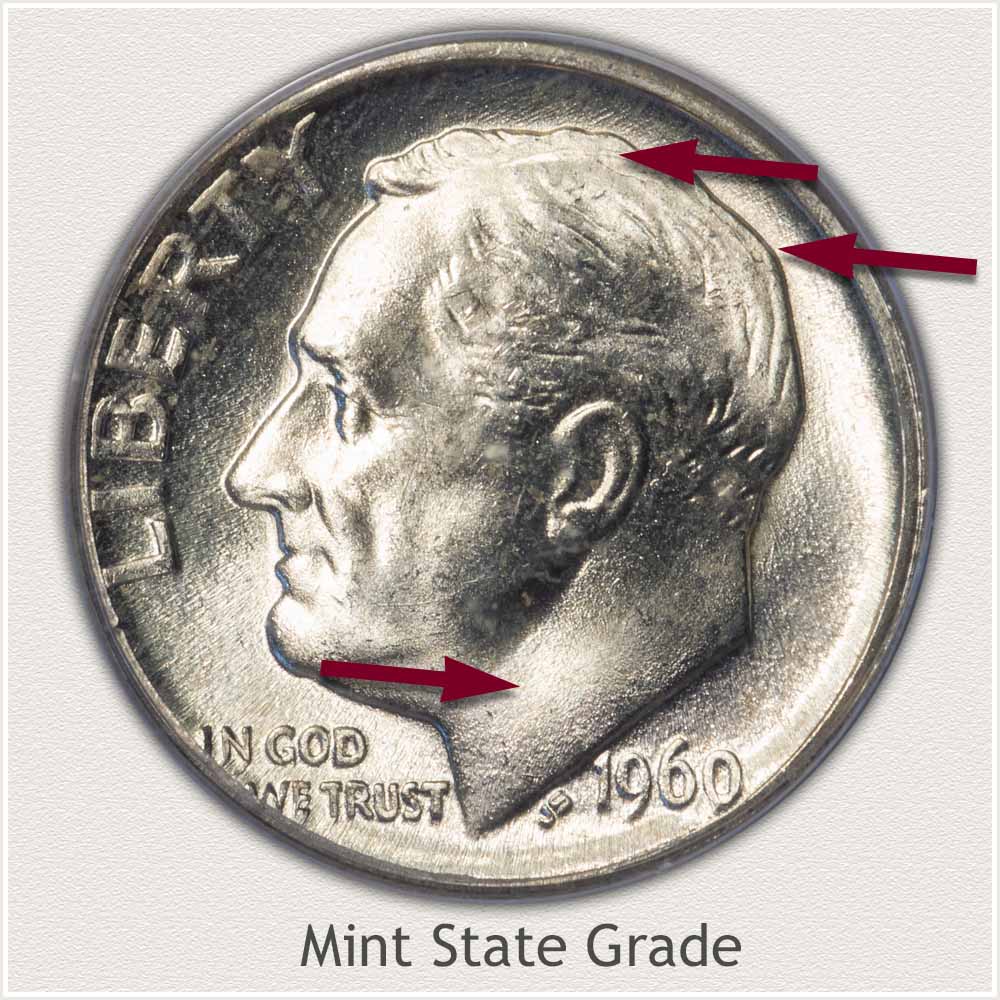
Mint State: A close view of the coin is needed to spot the details required to judge a Mint State coin. Defined as no wear to the surface, mint state examples remain covered with original luster.
Luster is a fine texture giving the surface its "shine". With the large portrait of Roosevelt covering the obverse design, many areas are prone to first signs of wear. Look closely at the hair at the back of the head on the example image. Luster covers the high areas between the lines within the hair. No smoothness is seen and the metal shines without any dulling. Wear reduces and smooths the metal and changes the color from a white-silver to a dull grey-silver.
Roosevelt's hair overall remains consistent in shine on mint state grade dimes. Hair at the back of the head is similar in look to the rest of the coin.
Extremely Fine Grade
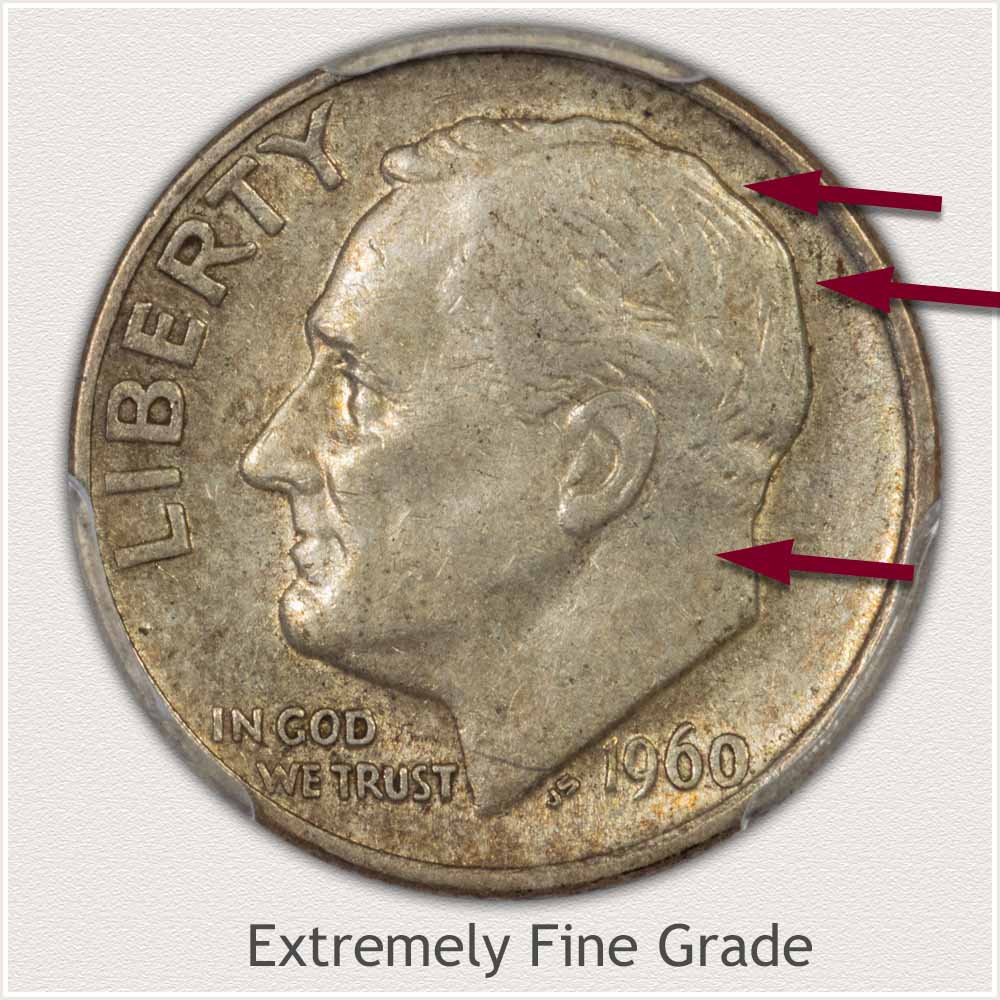
Extremely Fine: With only small amounts of wear visible, a dime is considered Extremely Fine in grade. The key is confirming wear is light and overall, the finer details remain.
Placing the dime in the example image within the extremely fine grade is the visible fine lines within the hair at the back of Roosevelt's head. Light wear is limited to the very tops of the high areas between the lines. Lines are only slightly faded.
Crisp detail is seen throughout the hair. Above the ear is well detailed, hair at the top of the head shows no flatness due to wear. All major contours of the face are high in profile.
Bullion Condition Examples
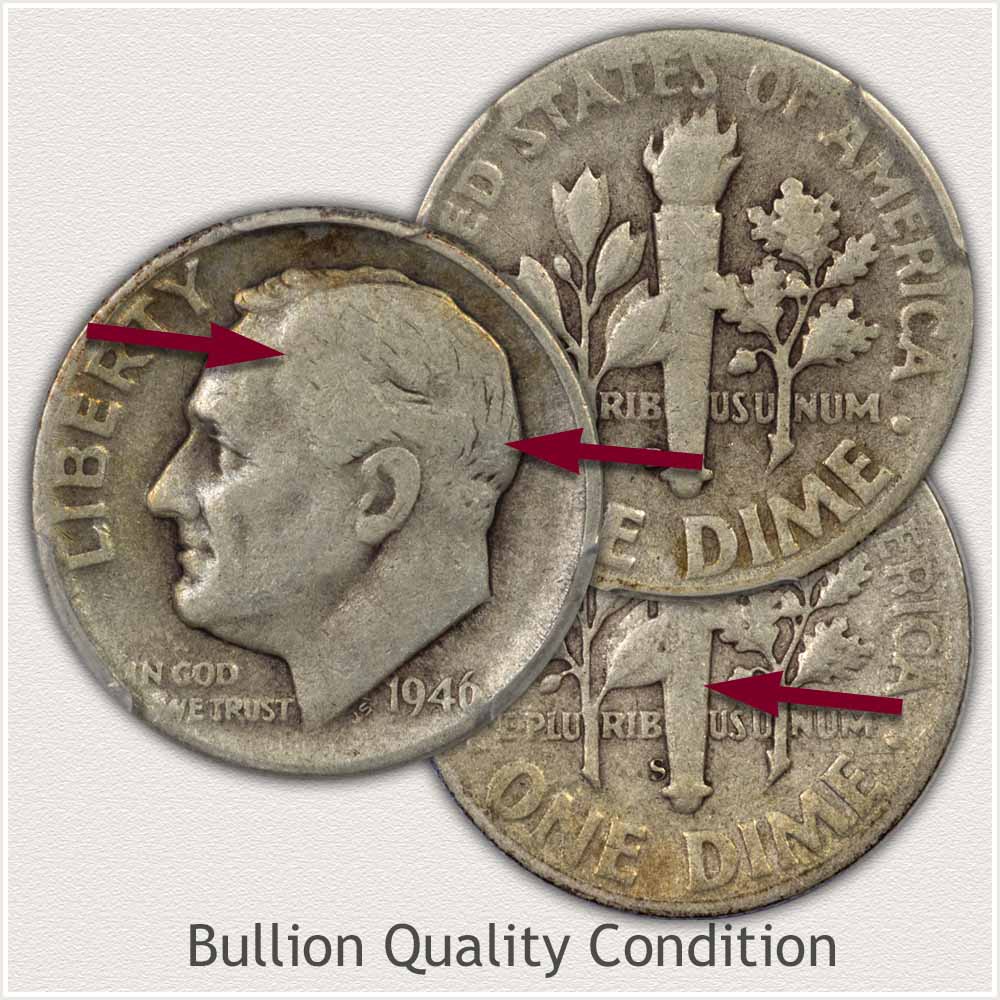
Bullion Condition Quality: Collectors of Roosevelt dimes seek high grade examples. Plentiful are the low condition 1960 dimes and these trade at silver value. With moderate to heavy wear visible on the dimes in the example image, these dimes have worn below the extremely fine grade and below collectible condition.
Bullion quality are dimes valued at their silver content. Notice the lack of details throughout Roosevelt's hair. Most line detail is faded and missing. At the back of his head, hair is showing large flat areas and only a few details.
Also, facial features appear as flattened areas. The cheek is a smooth area connecting with the smooth jaw. No high contours remain on the portrait of these moderately worn, bullion quality silver dimes.
How to Video: Grading Roosevelt Dimes
Confirm condition by grading of these silver dimes in greater detail and identifying subtle points to different grades.
Video, Images and Descriptions | Grading Roosevelt Dimes
Step 3: | Special Qualities Enhancing Value
The Premium Collector Silver Roosevelt Dimes
Two events of the early 1960's modified the value structure of the silver Roosevelt dime era.
First - A huge increase in production began to change the availability of these dimes. Saving of all dimes from circulation because of rising silver prices caused a shortage of coins. By 1960 mints needed to add large quantities of dimes to meet this demand. Result: 1960's silver dimes are available today in large quantities. More silver dimes were produced dated 1960 to 1964 than the rest of the series combined.
Secondly - A silver bullion market developed around the lower quality coins and high mintage dates of the silver series. This became a market separate of the collector market.
These two events lead to an increased focus of collectors on the date and mint combinations of the earlier years. A few coins began to stand out as elusive to find when compared to the rest of the series.
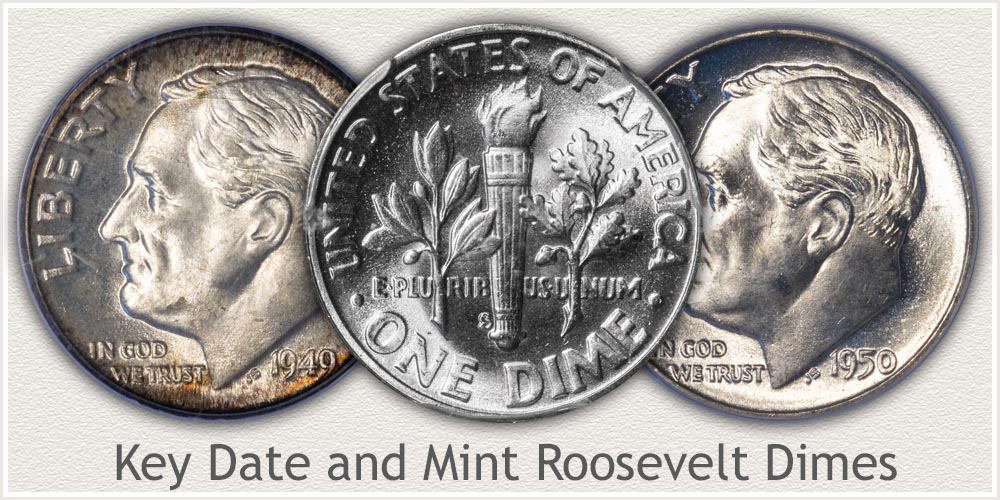
1949 is the year of the valuable key date Roosevelt dimes. In mint state grade the San Francisco variety is the value leader and considered the key to the series. The Philadelphia issue in mint state condition is second in value. Also, the 1949 Denver variety is priced well above the mint state average value of other coins.
1950 is also a notable year. The San Francisco mint issue is the premium coin in mint state grade, considered a key date in mint combination. Philadelphia and Denver 1950 dimes are also worth above the series average in mint state condition.
As a group, San Francisco silver Roosevelt dimes are thought of as semi-key issues. Prior to 1952 all are above average values.
Next are the premium circulated dates and mints of the silver era. Most Roosevelt dimes dated 1946 to 1964 in worn condition are valued based only on silver content. A few however are collectible in lightly worn condition and priced above silver content values.
1949 - all mint varieties are worth a close look. If found with just touches of wear on the high points they qualify as a premium coin. Joining these are the San Francisco coins of 1950 and 1951. Both are sought in the Extremely Fine grade and have collector value.
Two main markets are part of the Roosevelt silver dime era. Bullion quality, based on silver price. Collector quality with values based on availability and demand. Identifying the key dates and condition of these dimes finds the collector quality coins.
References
U.S. Mint. 1961 U.S. Mint Annual Report. https://nnp.wustl.edu/library/book/519605
Coin Values | CoinStudy Articles
Date by Date
In Depth Roosevelt Dime Values
1946 to 1964
Roosevelt Dime Values | 1946 to 1964
Collectible status separates the many date and mint varieties of early Roosevelt dime values. Silver is a strong base to the 1946 to 1964 era dimes. Condition identifies the coins collectors place a collector premium on. Chart listing silver Roosevelt dime values highlights the issues worth above silver content and in demand by collectors.
Print the Coin Values Worksheet
After following the steps above to evaluate your coins. List dimes by dates, mints and bullion quality to record their values.
Scarce and collectible dimes are found throughout the dime series. Many rare dimes are from the early mintage years. Bust dimes minted prior to 1850's are low mintage and highly sought. Seated Liberty, Barber, and Mercury dimes all have key rarities.
Silver Coin Values | Dimes to Dollars
Calculate current silver value of U.S. coinage. Silver dimes, quarters, halves, and dollars all move with the changing price of silver. These coins are heavy with silver and worth well above face value, changing daily.
★Coin Values Discovery finds 1960 Dime Value and...
U.S. coin values determined using a step-by-step process. Begin with identifying the major coin series covering cents to gold coins. Images are used throughout to compare dates, mint varieties, special varieties, and grading condition of your coins. Follow a few steps to narrow range on value charts.
